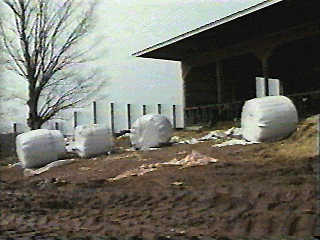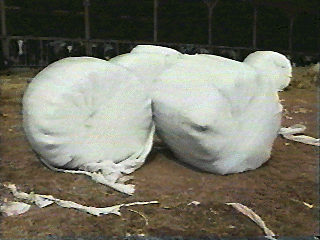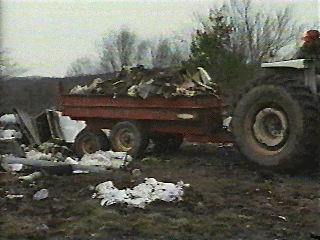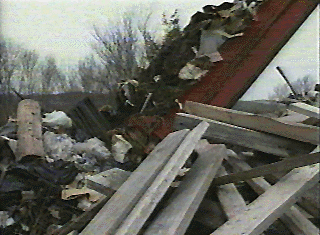
ITHACA, NY -- Plastic is everywhere in today's lifestyle. It's used for packaging, protecting, serving, and even disposing of all kinds of consumer goods. Consequently, a lot of plastic ends up at the solid waste facility where it might be recycled...or, it might be landfilled or incinerated. While it's true that local recycling programs are able to recover some types of plastics, many forms are still not practical to recycle, mainly because plastic can consist of different molecular compounds depending upon its original use. Separating these compounds can be both difficult and costly, and far beyond the capabilities of many municipalities.
One type of unrecyclable plastic steadily growing in use is low density polyethylene (LDPE) agricultural plastic film. LDPE agricultural film is gaining in popularity as an alternative for more traditional methods of storage. It can be found in agricultural operations as silo bunker covers, silage bags, bale wrap, greenhouse covers, haylage covers, row covers, and mulch film.

Agricultural plastic film is gaining in popularity as an alternative for more traditional methods of storage.
The upside of using this lightweight plastic agricultural film is that it can be more convenient and economical for farmers with short term storage requirements; the downside--there is a noticeable increase in the volume of LDPE agricultural plastic film waste being landfilled or burned, either on the farm or at local waste management facilities.
In order to assess the extent of plastic use and disposal in agricultural operations, the Cornell Waste Management Institute (CWMI) surveyed New York State farmers during the summer of 1994. The survey asked what types of films were used, how much was used, how dirty the film was after use, how it was currently being disposed of, and if farmers were interested in participating in a collection program.
Seventy-seven farmers responded, citing the most common uses as bale wrap, bunker silo covers, and horizontal silos. While most farmers said disposal of the used plastic was a problem (only seven percent had access to a dealer who recycled the plastic) most also said that as they discovered the advantages of plastic, they were using it more. Many indicated they tried to "recycle" the plastic film in various ways around the farm or by giving it to others for reuse. Ultimately, however, disposal was listed as a major problem. Eighty-five percent of the growers said they would be interested in a recycling program if available; most would be willing to store the used plastic until collection or would be willing to drop it off if a recycling site was conveniently located. Most, however, do not want to pay extra for this service.
A similar survey conducted by the University of Vermont Extension System found that the majority of farmers would be willing to take the necessary extra care needed to keep used agricultural films clean and deliver the materials to a recycling center if no fee was charged. This willingness dropped significantly when the question was changed to reflect a moderate fee.
Plastic Versus Traditional Storage Methods
In Sullivan County, New York, Colleen McKeon, Extension Educator, analyzed three storage methods commonly used for forage--the traditional upright silo, a "bunker" or horizontal silo, and a round bale wrapper to determine the economic viability of plastic use on the farm. The three methods compared each had the capacity to hold approximately 146 tons of forage, calculated on a dry matter basis to compensate for differences in moisture content which may have occurred.
The results of the analysis indicate that over a seven year period, a 10'x20'x100' concrete bunker silo is the most economical of the three methods, both in fixed costs and annual operating expenses. The bale wrapper came in second in terms of fixed and operating costs, but was the highest of the three in overall final costs. This is due mainly to the initial high cost of bale wrappers (which can be reduced if wrapping equipment is shared with neighboring farmers), but also to the increased amount of spoilage that can occur when using this method.
Plastic film does have some advantages over traditional storage methods. In many cases, the plastic wrap is used to reduce the risk of weather damage during harvesting. This new technology can enable a farmer to cut, bale, and wrap the hay all in one day, compared to the two to three days it would normally take to harvest dry hay for storing in silos.
Plastic bale wrapping is also ideal for farmers who harvest more than they can store in existing structures, but who do not want to invest more capital in additional buildings. Or, in some cases, forage is temporarily wrapped until a permanent structure can be constructed.

Plastic film can enable a farmer to cut, bale, and wrap the hay all in one day.
While all three methods are considered viable, efficient methods for storing forage, one question remains: what to do with the used plastic film once it has served its purpose?
Barriers to Effective Waste Management
As a follow-up to the farm survey, another study conducted by CWMI, Cornell Cooperative Extension, Black River-St. Lawrence Resource Conservation & Development, Canadian-U.S. Business Consulting Service at Clarkson University, and the NYS Department of Environmental Conservation explored current and possible waste management solutions for agricultural plastic film, conventional and possible alternatives, and the ability and willingness of recycling coordinators to participate in alternative management programs. Recycling representatives and waste disposal managers representing forty-three New York State Counties responded to the study survey questions. The study finds that:
Currently, most LDPE agricultural plastic film in NYS is managed on the farm through on-site landfilling and/or burning. This may in part be attributed to lack of education about adverse effects of this type of management, or the lack of incentives to use other forms of management. Many farmers have indicated they would like to recycle the materials but do not have an outlet for doing so. In areas where plastics are accepted at landfill or incineration facilities, high tipping fees may contribute to the farmers' unwillingness to utilize this option.
While most survey respondents agree that "closing the recycling loop," whereby agricultural plastic film is recycled and resold for farm use is critical, the loop cannot be effectively closed without cooperation from plastics manufacturers. While some manufacturers are attempting to deal with the waste associated with its increased use, most are only willing to manage the plastic if it is economically feasible.
Some plastics manufacturers who have tried recycling the used plastics have found the cost of cleaning, or lack of proper cleaning equipment, a deterrent. Levels of contamination of used LDPE can vary greatly; some mulch films and other agricultural films can have 50 percent or higher contamination levels by weight. Contamination comes from silage juices, pesticides, product residue from hay and haylage, moisture, vegetation, dirt and sand.
Research conducted at the University of Florida at Gainsville finds negative public perception of using products made from previously contaminated materials, particularly pesticide contamination. Plastic also deteriorates and more virgin plastic is needed to return the used plastic to its original strength. In addition high transportation costs associated with collecting the material; the inability to locate end markets; and the fact that LDPE is not considered a recyclable material by law in many states, offer no incentive for private or public haulers to collect the material separately. The Florida research concludes that a LDPE plastic recycling facility would need to recover a volume of 40,000 tons of LDPE plastic per year in order to break even financially--currently the only states recovering this amount of used plastic are California, Florida, and Texas.
In New York State, agricultural plastic waste currently represents a small component of the overall waste stream. Use of this nonrecyclable product is growing rapidly, however, and the study recommends that the problem of what to do with agricultural plastic wastes should be addressed while it is still manageable.
Addressing the Problem
A combination of efforts is suggested:
First, farmers are encouraged to practice waste reduction and revert to more durable and traditional means of storage whenever possible.
Secondly, ways to make recycling viable and economical for the farmers using these materials need to be found.
Finally, the barriers to effectively managing LDPE agricultural plastic film need to be eliminated--this includes finding cost-effective ways to conveniently collect, clean, and store the materials, and finding end markets for the recycled product.
Financial Implications of On-site Burning and Dumping
Creating awareness to the growing problem of agricultural waste and its disposal is also seen as key to the financial success of farms in New York and across the nation. Increasing societal interest in protecting the environment, the growing proximity of non-farm neighbors, and the potentially serious economic implications of cleaning up make the long term continuation of farm dumping and burning undesirable. Farm lenders are also concerned about the impact of on-site dumping and burning on long term collateral value. Developing a comprehensive plan for managing waste including waste reduction, composting, recycling, and taking advantage of the existing infrastructure in the community (i.e., recycling programs, haulers, transfer stations) is recommended to enhance the sustainability of farms.


A summary of the study "Agricultural Waste Market Research Study for New York State, Parts One and Two," is available free through CWMI. For more information, contact CWMI, 100 Rice Hall, Cornell University, Ithaca, NY 14853, cwmi@cornell.edu. Additionally, CWMI has produced a 9-minute video, "Farm Waste Management Makes $ense," (NRAES-111) designed to create awareness of solid waste issues and the financial implications on farms. The video ($19 plus postage and handling) is available through the Natural Resource, Agriculture, and Engineering Service, 152 Riley-Robb Hall, Cornell University, Ithaca, NY 14853. 607-255-7654. NRAES@cornell.edu.
|
|
Cornell Waste Management Institute 101 Rice Hall, Cornell University Ithaca, NY 14853-5601 607-255-1187 cwmi@cornell.edu |
|
| Department of Crop and Soil Sciences |
||